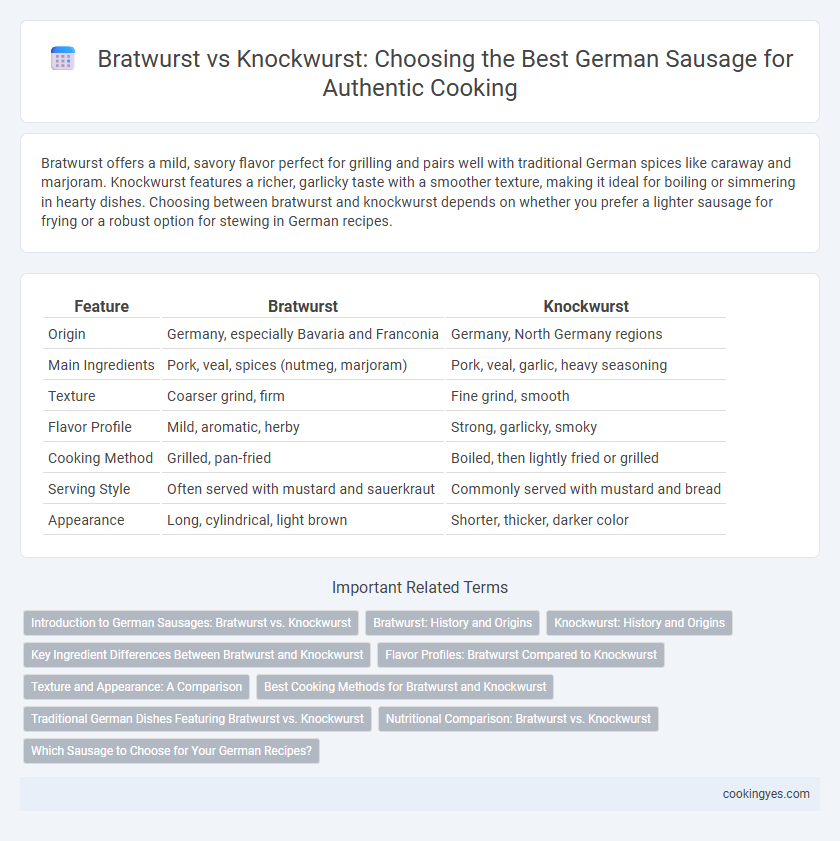Bratwurst offers a mild, savory flavor perfect for grilling and pairs well with traditional German spices like caraway and marjoram. Knockwurst features a richer, garlicky taste with a smoother texture, making it ideal for boiling or simmering in hearty dishes. Choosing between bratwurst and knockwurst depends on whether you prefer a lighter sausage for frying or a robust option for stewing in German recipes.
Table of Comparison
| Feature | Bratwurst | Knockwurst |
|---|---|---|
| Origin | Germany, especially Bavaria and Franconia | Germany, North Germany regions |
| Main Ingredients | Pork, veal, spices (nutmeg, marjoram) | Pork, veal, garlic, heavy seasoning |
| Texture | Coarser grind, firm | Fine grind, smooth |
| Flavor Profile | Mild, aromatic, herby | Strong, garlicky, smoky |
| Cooking Method | Grilled, pan-fried | Boiled, then lightly fried or grilled |
| Serving Style | Often served with mustard and sauerkraut | Commonly served with mustard and bread |
| Appearance | Long, cylindrical, light brown | Shorter, thicker, darker color |
Introduction to German Sausages: Bratwurst vs. Knockwurst
Bratwurst, a traditional German sausage made primarily from pork and veal, is known for its coarse texture and mild seasoning, often including nutmeg and coriander, best suited for grilling or pan-frying. Knockwurst, originating from northern Germany, features finely ground veal and pork with garlic and higher seasoning intensity, delivering a richer flavor and a softer, plump texture ideal for boiling or simmering. Both sausages represent distinct regional tastes and cooking methods within German cuisine, highlighting the diverse sausage-making traditions in Germany.
Bratwurst: History and Origins
Bratwurst, a traditional German sausage, traces its origins back to the Franconia region in the 14th century, where it was first mentioned in historical records. Made primarily from pork, veal, or beef, it is seasoned with spices like marjoram, which distinguishes it from the shorter, smoked knockwurst. Bratwurst holds a significant place in German culinary culture, often grilled and enjoyed during festivals such as Oktoberfest, reflecting its longstanding heritage and regional variations.
Knockwurst: History and Origins
Knockwurst, a traditional German sausage, originated in Northern Germany in the 19th century, particularly in Hamburg, reflecting a rich culinary heritage. Crafted from finely ground veal and pork, seasoned with garlic and other spices, knockwurst is known for its smooth texture and robust flavor. This sausage's history is distinct from bratwurst, which is generally coarser and spiced differently, making knockwurst a preferred choice in German cooking when a milder, garlic-forward taste is desired.
Key Ingredient Differences Between Bratwurst and Knockwurst
Bratwurst is primarily made from finely ground pork combined with veal or beef, seasoned with spices such as marjoram, nutmeg, and caraway, creating a mild and aromatic flavor profile ideal for grilling or pan-frying. Knockwurst consists of coarsely ground pork and veal, heavily spiced with garlic and sometimes mustard seeds, resulting in a rich and garlicky taste best suited for boiling or steaming. The distinct seasoning blends and meat textures define their unique roles in traditional German cuisine.
Flavor Profiles: Bratwurst Compared to Knockwurst
Bratwurst offers a mild, savory flavor with hints of nutmeg, marjoram, and garlic, making it ideal for grilling and pairing with mustard and sauerkraut. Knockwurst delivers a richer, smokier taste with a pronounced garlicky punch and a smoother, coarser texture due to its higher fat content and longer aging process. Both sausages reflect distinct regional traditions in German cuisine, with bratwurst emphasizing subtle herbaceous notes and knockwurst showcasing bold, smoky intensity.
Texture and Appearance: A Comparison
Bratwurst features a coarse ground texture with a pale beige color, often boasting visible spices and herbs that enhance its rustic appearance. Knockwurst has a finer, smoother texture with a pinkish hue due to its higher fat content and shorter curing process. In German cooking, bratwurst offers a firmer bite ideal for grilling, while knockwurst delivers a juicier, softer mouthfeel perfect for boiling or simmering.
Best Cooking Methods for Bratwurst and Knockwurst
Bratwurst, a traditional German sausage made from pork, veal, or beef, is best cooked using grilling or pan-frying to achieve its signature crispy exterior and juicy interior. Knockwurst, characterized by its shorter, plumper shape and higher fat content, benefits from simmering or boiling followed by quick roasting or grilling to preserve its tender texture and enhance flavor. Both sausages require careful temperature control, with bratwurst cooked to an internal temperature of 160degF and knockwurst to 140degF for optimal safety and taste.
Traditional German Dishes Featuring Bratwurst vs. Knockwurst
Bratwurst, typically made from pork and veal, is a staple in traditional German dishes like Currywurst and Bratwurst mit Sauerkraut, offering a savory, slightly spicy flavor profile. Knockwurst, characterized by its short, plump shape and coarse grind of pork and veal, is commonly featured in rich dishes such as Knockwurst with mustard and potato salad, prized for its smoky, garlicky taste. Both sausages are integral to authentic German cuisine, with regional recipes highlighting their distinctive textures and seasoning.
Nutritional Comparison: Bratwurst vs. Knockwurst
Bratwurst typically contains lower fat content and calories compared to knockwurst, making it a leaner option for German cooking enthusiasts. Knockwurst features higher protein levels but also has increased saturated fat and sodium, contributing to its richer flavor. Nutritional choices between bratwurst and knockwurst depend on dietary goals, balancing protein intake with fat consumption in traditional German cuisine.
Which Sausage to Choose for Your German Recipes?
Bratwurst offers a mild, finely ground pork flavor ideal for grilling or pan-frying in traditional German recipes, while knockwurst features a coarser texture with a garlic-forward, smoky taste perfect for boiling or steaming. Choosing bratwurst complements dishes like currywurst or sauerkraut bowls, enhancing savory, subtle flavors, whereas knockwurst adds depth to meals requiring a robust, smoky sausage presence. For authentic German cooking, select bratwurst to achieve a tender, classic profile or knockwurst when a richer, more intense sausage is desired.
Bratwurst vs knockwurst for German cooking Infographic

 cookingyes.com
cookingyes.com